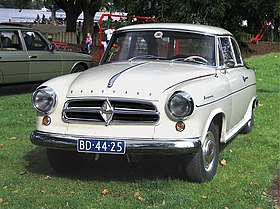Borgward Isabella
| Borgward Isabella | |
|---|---|

Borgward Isabella Saloon (1960)
|
|
| Overview | |
| Manufacturer | Carl F. W. Borgward GmbH |
| Also called | Borgward Hansa Isabella |
| Production | June 1954-1962 |
| Assembly | Bremen-Sebaldsbrück |
| Body and chassis | |
| Body style |
2 door saloon cabriolet station wagon coupe (2+2) cabriolet (2+2) 2-door pickup |
| Layout | FR layout |
| Powertrain | |
| Engine | 1493 cc 75hp straight-4 |
| Transmission | 4-speed manual |
| Dimensions | |
| Wheelbase | 2,600 mm (100 in) |
| Length | 4,390 mm (173 in) |
| Width | 1,705 mm (67.1 in) |
| Height | 1,480 mm (58 in) |
| Curb weight | 1,010 kg (2,230 lb) |
| Chronology | |
| Predecessor | Borgward Hansa 1800 |
The Borgward Isabella is an automobile which was manufactured by the Bremen based auto-manufacturer Carl F. W. Borgward GmbH from 1954 to 1962.
The Isabella was to have been marketed as the Borgward Hansa 1500 but the Isabella name was used on test vehicles and proved popular with engineering staff and media. The production car was subsequently renamed and only the first few hundred examples were built without Isabella badging. Hansa badging was also used through to 1957.
Despite its aspirational positioning in the marketplace, the Isabella had a smaller engine (and was marginally shorter) than its immediate predecessor, the Borgward Hansa. Late in 1952, the firm had launched their six-cylinder Hansa 2400 model. The larger car never found many buyers; but in 1954, it made commercial sense to keep the two models from competing too directly with each other.
11,150 Isabellas were produced in 1954, an early indicator that commercially this would be the most successful Borgward ever. The early cars enjoyed an enthusiastic reception in the market place. Unfortunately, early models were afflicted by teething troubles, reflecting a rushed development schedule, and the marketplace would later prove unforgiving as Borgward's Stuttgart based rival, Daimler-Benz demonstrated that new models did not have to involve customers experiencing such problems.
The advertised launch price of DM 7,265 was higher than that of competitor family sedans from Opel and Ford, but significantly less than Mercedes Benz was asking for their 180 model. In view of the car's spacious cabin antd impressive performance, the pricing was perceived as very competitive. A road test at launch reported a maximum speed of 130 km/h (81 mph) and fuel consumption of 8.4 l/100 km. The testers described the modern structure of the car in some detail: they particularly liked the wide cabin with its large windows, and they commended the effectiveness of the brakes. The inclusion of a cigarette lighter and a clock also attracted favourable mention. Unlike the Mercedes 180 however, (and unlike its predecessor) the Isabella was only delivered with two-doors.
The Isabella was constructed without a separate chassis, applying the monocoque technique which during the 1950s was becoming the norm. Like its predecessor, the car was designed with a modern ponton, three-box design, but the line of the Isabella was more curvaceous than that of the first Hansa, and the car’s body made greater use of chrome trim. Ground clearance was 6.9".
...
Wikipedia
